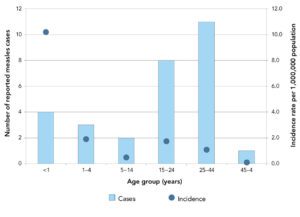Introduction
Measles was once a common childhood illness, but thanks to successful vaccination programs, Canada declared the disease eliminated by the early 2000s. However, in 2025, measles has re-emerged in Calgary and other parts of the country, posing a renewed threat to public health. While the number of cases remains relatively low, the potential for outbreaks is serious, especially in communities with lower vaccination rates.
At Remedy Pills Pharmacy, we believe that knowledge is power. Understanding measles—how it spreads, its symptoms, possible complications, and prevention—is essential for every family in Calgary. This article will guide you through everything you need to know about measles in 2025, helping you protect yourself and your loved ones.
What is Measles?
Measles is an acute viral respiratory illness caused by the measles virus, a member of the paramyxovirus family. It primarily affects the respiratory tract but can become systemic, impacting many parts of the body.
Symptoms
The disease typically starts with a high fever, often exceeding 39°C (102°F). Accompanying this fever are several other hallmark symptoms:
Cough: A dry, persistent cough often develops.
Runny nose (coryza): Similar to a cold, causing nasal congestion and discharge.
Red, watery eyes (conjunctivitis): The eyes may appear bloodshot and sensitive to light.
Koplik spots: Small white spots with bluish-white centers found inside the mouth on the inner lining of the cheeks. These are highly characteristic of measles and usually appear 2-3 days before the rash.
Rash: A red, blotchy rash appears about 3-5 days after initial symptoms, starting behind the ears and on the face, then spreading downward to cover the neck, trunk, arms, legs, and feet.
The rash usually lasts about 5-6 days before fading. The illness itself often lasts 7 to 10 days, but some symptoms like cough and fatigue may persist longer.
Complications
While many people recover without lasting effects, measles can lead to severe complications, especially in children under 5 years old, adults over 20, pregnant women, and immunocompromised individuals .
.
Common complications include:
Pneumonia: This is the most common cause of measles-related death. Measles can cause a viral pneumonia or increase susceptibility to bacterial pneumonia.
Otitis media (ear infections): These infections can cause temporary or permanent hearing loss.
Diarrhea and dehydration: Especially dangerous for young children.
Encephalitis: Brain inflammation, which can lead to permanent brain damage, seizures, or death.
Subacute sclerosing panencephalitis (SSPE): A rare, fatal brain disorder occurring years after measles infection.
Measles also causes temporary immune suppression that lasts weeks to months, making survivors more vulnerable to other infections.
How Measles Spreads
Measles is one of the most contagious diseases known. It spreads through respiratory droplets released when an infected person coughs, sneezes, or talks. The virus can remain viable and infectious in the air or on surfaces for up to two hours, meaning you can contract measles by simply entering a room where an infected person was recently present.
Contagious Period
An infected person is contagious from about four days before the rash appears until four days after it begins. During this time, they can easily transmit the virus to others.
High-Risk Environments
Measles spreads rapidly in crowded places such as schools, daycare centers, hospitals, public transit, airports, and other enclosed spaces. Because of its airborne transmission, measles can infect people who were not in direct contact with the sick individual.
Infectivity Rate
A person with measles can infect 12 to 18 unvaccinated people on average. This is far more contagious than the seasonal flu or COVID-19, which usually infect fewer people per case.
Measles in Calgary in 2025: Current Status and Challenges
Despite previous success in eliminating measles in Canada, the disease has made a comeback in Calgary. As of mid-2025, Alberta Health Services has confirmed 12 cases, with outbreaks mainly concentrated in under-immunized communities or among unvaccinated travelers returning from abroad.
While the total number may seem small, it represents a significant risk given the ease of transmission. The vaccination coverage in Calgary has dropped to approximately 87%, below the 95% needed to maintain herd immunity, the community-wide protection that prevents outbreaks.
Why Herd Immunity Matters
Herd immunity occurs when a high percentage of the population is immune to a disease, making its spread unlikely. This protects vulnerable groups who cannot be vaccinated, such as infants under 12 months and immunocompromised people.
When vaccination rates fall below the herd immunity threshold, measles outbreaks become more frequent and severe.
Table 1: Key Milestones in the History of Measles
| Year | Event | Significance |
|---|---|---|
| 9th Century | First clinical description by Rhazes | Early medical understanding of measles |
| 1954 | Virus isolated and identified | Allowed development of the vaccine |
| 1963 | First measles vaccine licensed | Start of widespread immunization programs |
| 1980s | Two-dose vaccination schedules introduced | Improved immunity and outbreak prevention |
| Early 2000s | Measles declared eliminated in Canada | No sustained local transmission |
| 1998 | Discredited MMR-autism study published | Led to vaccine hesitancy and reduced coverage |
| 2010s-2020s | Measles outbreaks re-emerge globally | Due to vaccine hesitancy and international travel |
Why Are Measles Cases Rising Again?
Several factors contribute to the resurgence of measles in Calgary and other regions:
Vaccine Hesitancy
Misinformation about vaccine safety, largely spread through social media and internet forums, has led some parents to delay or refuse vaccines. The 1998 fraudulent study falsely linking MMR vaccination to autism remains a significant source of public fear despite being thoroughly debunked.
International Travel
Calgary’s international connections mean travelers can bring measles back from countries where the disease remains common. This importation can lead to outbreaks in local under-vaccinated populations.
Gaps in Vaccine Coverage
Vaccination rates below 95% allow the virus to spread. Pockets of unvaccinated or undervaccinated individuals provide an easy pathway for measles outbreaks.
Table 2: Interesting Facts About Measles
| Fact | Explanation |
|---|---|
| Measles is among the most contagious viruses | One person can infect up to 18 others |
| Virus can survive in air or on surfaces for 2 hours | Infection possible without direct contact |
| Two doses of MMR vaccine are 97% effective | Provides strong protection against measles |
| Measles was once a leading cause of childhood death | Before vaccines, millions died worldwide yearly |
| Virus causes immune suppression lasting months | Increases risk for other infections |
| 95% vaccination coverage needed for herd immunity | Critical to prevent outbreaks |
| Symptoms appear 10-14 days post-exposure | Known as incubation period |
The MMR Vaccine: Your Best Defense
The MMR (Measles, Mumps, and Rubella) vaccine is safe, effective, and the most reliable protection against measles. It is provided free in Alberta’s public health system and offered at many pharmacies including Remedy Pills Pharmacy.
Vaccination Schedule
The vaccine is given in two doses:
First dose: At 12-15 months of age
Second dose: At 4-6 years of age
Adults born after 1970 without documented vaccination or past infection should consider vaccination as well.
Vaccine Effectiveness and Safety
Two doses of the MMR vaccine are approximately 97% effective at preventing measles infection. Side effects are generally mild and temporary, such as soreness at the injection site or a mild fever. Serious side effects are extremely rare.
Why Vaccination Matters
Vaccination protects individuals from severe illness and also helps achieve herd immunity, indirectly protecting those who cannot be vaccinated.
Table 3: Measles Complications and Their Frequency
| Complication | Frequency (Approximate) | Notes |
|---|---|---|
| Pneumonia | 1 in 20 measles cases | Leading cause of measles-related deaths |
| Diarrhea | 1 in 10 cases | Can cause dehydration, especially in children |
| Ear infection (Otitis media) | 1 in 10 cases | May lead to hearing loss |
| Encephalitis (brain swelling) | 1 in 1,000 cases | Can cause permanent brain damage or death |
| Death | 1-2 in 1,000 cases | Rare but possible in developed countries |
Table 4: MMR Vaccination Schedule (Alberta)
| Age Group | Dose | Notes |
|---|---|---|
| 12 to 15 months | First dose of MMR | Given during the 1-year checkup |
| 4 to 6 years | Second dose of MMR | Booster dose for lasting immunity |
| Adults born after 1970 | 1 or 2 doses if no prior vaccination or immunity | Especially for travelers or healthcare workers |
What to Do If You Suspect Measles
If you or your child develops symptoms such as a high fever, cough, runny nose, red eyes, and a rash, you should take the following steps immediately:
Isolate the patient: Keep them away from others, particularly infants, pregnant women, and immunocompromised individuals.
Contact your healthcare provider or pharmacist: Call before visiting a clinic or hospital to avoid exposing others.
Follow public health guidance: Testing and reporting help contain outbreaks.
Notify close contacts: Anyone exposed who is unvaccinated may need post-exposure vaccination or monitoring.
How Remedy Pills Pharmacy Supports You
Remedy Pills Pharmacy is dedicated to supporting Calgary families in managing their health proactively. We provide:
Immunization reviews and advice to ensure your family is up to date.
Administration of vaccines, including MMR boosters.
Educational resources on measles and other vaccine-pre






